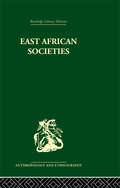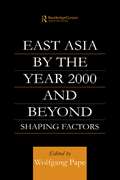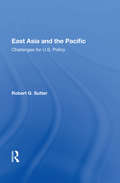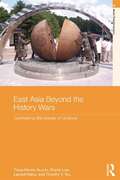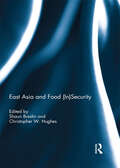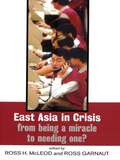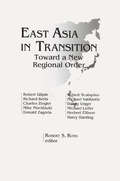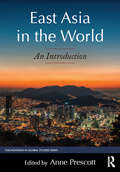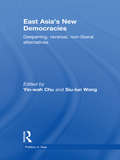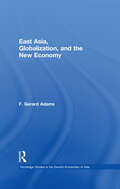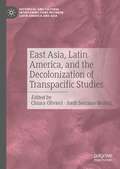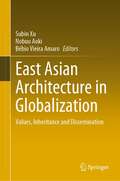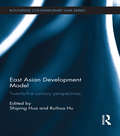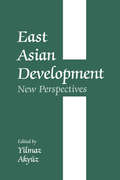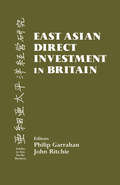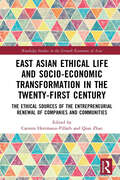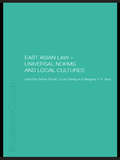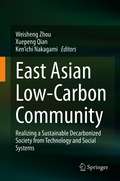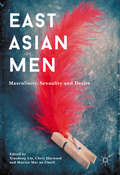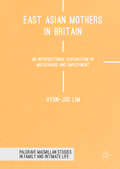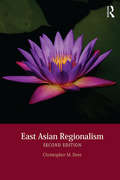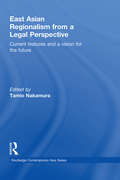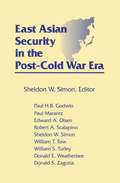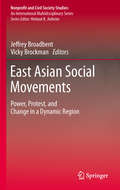- Table View
- List View
East African Societies (Library Of Man Ser.)
by Aylward ShorterFocussing on the mechanics of social change and the interaction between ethnic groups, cultures, structures and value systems the background questions of ecology, demography and history are also examined and the process of urbanization and rural revolution described. Trends in marriage and family life, education and religious ideas are also discussed and case studies from each country included. First published in 1974.
East Asia 2000 and Beyond: Shaping Factors/Shaping Actors (English-language Series Of The Institute Of Asian Affairs Ser. #Vol. 1)
by Wolfgang PapeThis wide ranging survey uses the latest methodological apparatus including sophisticated computer modelling techniques to identify the key political, social and economic trends which are likely to shape the East Asian region at the millennium and beyond.
East Asia And The Pacific: Challenges For U.s. Policy
by Robert G. SutterAs the cold war ends, the United States is being forced to reassess the dominant role it has played in East and Southeast Asia and the Pacific during the decades that followed World War II. Bringing readers up to date on policy trends in the area, the author provides a general overview as well as detailed analyses of key issues in individual nations and regions. The author concludes by placing these regional developments in the context of the ongoing debate in the United States over an appropriate foreign policy in the post-cold war world.
East Asia Beyond the History Wars: Confronting the Ghosts of Violence (Asia's Transformations)
by Tessa Morris-Suzuki Timothy Y. Tsu Morris Low Leonid PetrovEast Asia is now the world’s economic powerhouse, but ghosts of history continue to trouble relations between the key countries of the region, particularly between Japan, China and the two Koreas. Unhappy legacies of Japan’s military expansion in pre-war Asia prompt on-going calls for apologies, while conflicts over ownership of cultural heritage cause friction between China and Korea, and no peace treaty has ever been signed to conclude the Korean War. For over a decade, the region’s governments and non-government groups have sought to confront the ghosts of the past by developing paths to reconciliation. Focusing particularly on popular culture and grassroots action, East Asia beyond the History Wars explores these East Asian approaches to historical reconciliation. This book examines how Korean historians from North and South exchange ideas about national history, how Chinese film-makers reframe their views of the war with Japan, and how Japanese social activists develop grassroots reconciliation projects with counterparts from Korea and elsewhere. As the volume’s studies of museums, monuments and memorials show, East Asian public images of modern history are changing, but change is fragile and uncertain. This unfinished story of East Asia’s search for historical reconciliation has important implications for the study of popular memory worldwide. Presenting a fresh perspective on reconciliation which draws on both history and cultural studies, this book will be welcomed by students and scholars working in the fields of Asian history, Asian culture and society as well as those interested in war and memory studies more generally.
East Asia and Food (In)Security
by Shaun Breslin and Christopher W. HughesThis book presents a study of perceptions of food insecurity in East Asia, and explores how individual countries are developing strategies to deal with the situation. It also looks at how the perception of food insecurity has increasingly influenced the nature of international interactions, not just within East Asia, but also in the region’s relations with major external actors. Many of the challenges facing East Asia are generic food security issues that face people and governments across the world – for example, the implications of climate change and demographic changes on food supplies. This book places the East Asian context in the wider discussion of food (in)security in global politics. However, it also identifies potential regional ‘differences’ – for example, the significance of rice for the region, and the unavoidable impact of China as a major regional player. What the Chinese state, and Chinese companies, decide to do in response to concerns about food insecurity have an impact not just on the rest of the region, but on the rest of the world. Taking too much of a Sinocentric focus, however, ignores other actors in East Asia, or merely relegates discussion to how they respond to Chinese policies or external strategies. This book considers the region as a whole, both when it comes to thinking about food security challenges and responses within the region itself, and also in the outward projection of regional food insecurity on the rest of the world.This book was published as a special issue of The Pacific Review.
East Asia in Crisis: From Being a Miracle to Needing One?
by Ross Garnaut Ross H. McLeodThe current economic crisis in East Asia is unprecedented in world economic history. It seemed the economic strength of the region, until very recently, would just keep growing. Now, the macroeconomic achievements of Asia are under threat and the economies of North America and Europe are feeling the results. This book brings together the thoughts of leading experts on the Asian economy and provides a broad and thorough analysis of the situation. It provides case studies from fourteen countries in the region, how the crisis developed and affected them, and the response from governments. There are other non-country specific chapters with a strong theoretical content which address issues such as causation, how such a crisis should be handled, how it might be avoided in the future, and the likely implications for on-going deregulatory and other economic reforms. This is an important authoritative account of one of the most extraordinary economic events and provides a broad synthesis of case studies and theoretical approaches from a variety of researchers with an intimate knowledge of the region.
East Asia in Transition: Toward a New Regional Order
by Robert S. Ross"Has uniformly good essays on economic and political change, the policies of the great and local powers, and the prospects for building a new regional order". -- Foreign Affairs
East Asia in the World: An Introduction (Foundations In Global Studies)
by Anne PrescottFrom the Foundations in Global Studies series, this text offers students a fresh, comprehensive, multidisciplinary entry point to East Asia. After a brief introduction to the study of East Asia, the early chapters of the book survey the essentials of East Asian history; important historical narratives; and the region's languages, religions, and global connections. Students are guided through the material with relevant maps, resource boxes, and text boxes that support and guide further independent exploration of the topics at hand. The second half of the book features interdisciplinary case studies, each of which focuses on a specific country or region and a particular issue. Each chapter gives a flavor for the cultural distinctiveness of the particular country yet also draws attention to global linkages. Readers will come away from this book with an understanding of the larger historical, political, and cultural frameworks that shaped East Asia as we know it today, and of current issues that have relevance in Asia and beyond.
East Asia's New Democracies: Deepening, Reversal, Non-liberal Alternatives (Politics in Asia)
by Yin-Wah ChuThis collection brings us up-to-date on the contemporary situations in the new democracies of East Asia, and debates on the prospect of introducing liberal democracy to this part of the world. The chapters cover a wide range of cases, including in-depth examination of China, Korea, Taiwan, the Philippines, Thailand, and broad comparisons of Malaysia, Singapore, Indonesia, Vietnam, and other countries. The contributors, who are foremost experts in their fields, examine the roles performed by civil society, social classes, and strategic groups, as well as the intertwining of values and interests in the transition to, consolidation of, and reversal from democracy. They also evaluate the extent to which these new democracies have facilitated regional peace, helped extend social welfare benefits, bolstered poverty alleviation, and upheld the rule of law and human rights. Grounding their analyses in the historical development of these societies, and/or examining them through the comparative strategy they also explore the desirability of liberal democracy, whether in the subjective assessment of the Asian people or in relation to the social-political challenges faced by these Asian countries. East Asia’s New Democracies will be of interest to students and scholars of comparative politics, political science, political sociology, East and Southeast Asian studies.
East Asia, Globalization and the New Economy (Routledge Studies in the Growth Economies of Asia)
by F. Gerard AdamsWe are witnessing a transformation in the world economy as a result of the IT/e-business revolution. Modern logistics based on cheap communication and transportation are shifting the locus of production and the international division of labour between the West and the lower wage countries of East Asia and similar changes are occurring within East Asia itself. Looming over the entire picture is the colossus that is China and this transformation is making East Asia the manufacturing centre of the world economy. Written by a recognized expert in the area of business economics, this book analyzes these developments and evaluates their future impact on the development of East Asia and its role in the world economy. The book examines the effect of the IT revolution, globalization and the 'new economy' on the development of East Asia. The first book-length treatment of IT/e-business in the region, it questions whether the e-business revolution will renew and sustain the rapid economic development of East Asia.
East Asia, Latin America, and the Decolonization of Transpacific Studies (Historical and Cultural Interconnections between Latin America and Asia)
by Chiara Olivieri Jordi Serrano-MuñozIn this collective work, researchers from different disciplines reflect upon the challenges and opportunities of decolonizing transpacific studies through the lens of a few paradigmatic case-studies that deal with connections between East Asia and Latin America. The present book offers a productive problematization of the idea of the transpacific as a concept and a space that is not restricted to a single definition. We defend that the transpacific can instead promote an understanding of agents and experiences that share many common traits that have been generally overlooked by a hegemonic interpretation of knowledge and the relationship between regions.By fostering an environment that not only accepts a plurality of views but that actively looks to accommodate analogous, tangential, and even contradicting approaches to the study of our ideas, we seek a double objective. First, we hope to highlight precisely the richness within the idea of the transpacific, avoiding sticking to any particular conception to it while at the same time acknowledging and owning each of our points of enunciation. Our second objective is part of a constant struggle in the quest towards social and epistemic justice. By adopting this stance of plurality, we can fight against structures of knowledge production and reproduction that willingly or unintentionally instill specific interpretations in ways that inculcate exclusivity.The goal of this book is opening up and expanding the debate regarding transpacific connections, examining the limits and promises of including these experiences within the conceptual paradigm of the Global South, and showcasing different ways of approaching decolonial research to the study of the relationship between East Asia and Latin America.
East Asian Architecture in Globalization: Values, Inheritance and Dissemination
by Subin Xu Nobuo Aoki Bébio Vieira AmaroThis book collects a selected list of peer-reviewed papers presented at EAAC 2017, International Conference on East Asian Architectural Culture, the leading conference on architectural history and built heritage conservation in the East Asia region. While centered around the core issue of globalization and its complex effects on East Asian architectural cultures, the selected papers were arranged into four major sub-topics: Historical & Theoretical Research; Conservation Methodology & Technology; Adaptive Reuse; and Community Design. All together, this collection showcases the most recent disciplinary developments in East Asian countries, as well as the main concerns and prospects of leading practitioners. The wide range of contributions and perspectives included here in English language for a global audience should be of considerable appeal to all scholars and professionals in the fields of architectural and urban design, history of the built environment, and heritage conservation policies and methods.
East Asian Development Model: Twenty-first century perspectives (Routledge Contemporary Asia Series)
by Shiping Hua Ruihua HuGiven the impressive growth in East Asia after World War II, initially led by Japan, the region's development models have been scrutinized since the 1980s. The shared Confucian cultural heritage, strong government guidance, and export led economies were often cited as contributors to the impressive growth. However, major changes have taken place in Asia on and around the turn of the century: Japan experienced two decades of economic slow-down, while World Bank figures reveal that China is poised to become the largest economy in the world in 2014, overtaking the United States. Bearing this in mind, is it even possible to formulate an East Asian development model in the context of a shifting twenty-first century? And if so, what is it? This book addresses this issue by looking at the economic, political and cultural perspectives of China, Japan and South Korea, focusing on dynamism and potential consensus regarding an East Asian development model. The chapters offer a historical background to the East Asian development model, as well as in-depth case studies of each of the countries concerned to show that whilst the East Asian development model does have distinct characteristics as compared with other areas, and other countries may draw some insights from the East Asian experience, it is not a panacea that fits all circumstances and fits all times. This book will be welcomed by students and scholars of Asian economics, Asian politics, international political economy and development studies.
East Asian Development: New Perspectives
by Yilmaz AkyüzThis collection of papers challenges the conventional view of East Asian development driven by open and efficient markets and suggests that considerable diversity both at the institutional level and in policy approaches lies behind the region's rapid economic growth.
East Asian Direct Investment in Britain (Studies In Asia Pacific Business)
by John Ritchie Philip GarrahanThe contributions investigate indicators of change and the interaction with FDI from East Asia against the background of changes in the regional economy since the mid 1980s. They discuss in particular how the North tackled long-term decline and the long-term implications for the region.
East Asian Ethical Life and Socio-Economic Transformation in the Twenty-First Century: The Ethical Sources of the Entrepreneurial Renewal of Companies and Communities (Routledge Studies in the Growth Economies of Asia)
by Carsten Herrmann-Pillath Qian ZhaoThis book considers ethical culture in East Asia, examines the impact it has had on economic and social transformation, and explores what effect it might have on solving current problems. It views the ethical culture of East Asia, that is, the beliefs, values, and practices that define East Asian societies’ conceptions of ethics in everyday life, as different from what pertains in the West, with more emphasis in East Asia on respect for ancestors, concern about propriety of behaviour, and notions of community. The book discusses how these particular East Asian values are being applied, for example, in family businesses, and how they might further be applied to solve current crucial challenges for humanity, such as climate change, ageing, and persistent inequality, challenges that are not being solved by an exclusive focus on economic growth alone. The book includes a consideration of ethical innovation, for example, distinct forms of ecological ethics enshrined in newly emerging economic organizations, such as social entrepreneurship.
East Asian Law: Universal Norms and Local Cultures
by Lucie Cheng Arthur Rosett Margaret Y.K. WooThis work explores the tension in East Asia between the trend towards a convergence of legal practices in the direction of a universal model and a reassertion of local cultural practices. The trend towards convergence arises in part from 'globalisation', from 'rule of law programs' promulgated by institutions such as the International Monetary Fund and the Asian Development Bank, and from widespread migration in the region, whilst the opposing trend arises in part from moves to resist such 'globalisation'. This book explores a wide range of issues related to this key problem, covering China in particular, where resolving differences in conceptions about the rule of law is a key issue as China begins to integrate itself into the World Trade Organisation regime.
East Asian Low-Carbon Community: Realizing a Sustainable Decarbonized Society from Technology and Social Systems
by Ken’ichi Nakagami Weisheng Zhou Xuepeng QianThis book presents new vision of regional de-carbonization with concrete scheme design and substantial quantitative demonstration from original interdisciplinary studies. It provides new horizon for not only climate change, environmental conservation but also for international cooperation and peace in East Asia. The chapters introduce diverse low carbon society principles from local to global level with best practices integrating technology evolution and social innovation. While the book is designated for academics and the ultimate goal is to facilitate international climate regime making and environmental cooperation, local government and international organizations (United Nations, World Bank, and others) officers, researchers, international NGO/NPOs, consultants, students (particularly those studying environmental policy studies or international relationships), as well as reporters will find this book useful in broadening their understanding of low-carbon development in East Asia.
East Asian Men: Masculinity, Sexuality and Desire
by Xiaodong Lin, Chris Haywood and Mairtin Mac an GhaillThis book provides a fresh and contemporary take on the study of men and masculinity. It highlights new and exciting approaches to sexuality, desire, men and masculinity in East Asian contexts, focusing on the interconnections between them. In doing so, it re-examines the key concepts that underpin studies of masculinity, such as homophobia, homosociality and heteronormativity. Developing new ways of thinking about masculinity in local contexts, it fills a significant lacuna in contemporary scholarship. This thought-provoking work will appeal to students and scholars of gender studies, cultural studies and the wider social sciences.
East Asian Mothers in Britain: An Intersectional Exploration Of Motherhood And Employment (Palgrave Macmillan Studies in Family and Intimate Life)
by Hyun-Joo LimHow do Chinese, Japanese and Korean mothers in Britain make sense of their motherhood and employment? What are the intersecting factors that shape these women’s identities, experiences and stories? Contributing further to the continuing discourse and development of intersectionality, this book examines East Asian migrant women’s stories of motherhood, employment and gender relations by deploying interlocking categories that go beyond the meta axes of race, gender and class, including factors such as husbands’ ethnicities and the locality of their settlement. Through this, Lim argues for more detailed and context specific analytical categories of intersectionality, enabling a more nuanced understanding of migrant women’s stories and identities. East Asian Mothers in Britain will appeal to students and scholars across a range of disciplines and with an interest in identity, gender, ethnicity, class, migration and intersectionality.
East Asian Pop Culture
by Chua Beng HuatThe International group of contributors of this volume provides, collectively, a multi-layered analysis of the emerging East Asian media culture, using the Korean TV drama as its analytic vehicle. By closely examining the political economy of TV industry, audiences of the regional media flows in terms of gender subjectivity constructions, perceptions of colonial-postcolonial relationships, and nationalist responses to trans-national media culture exchanges, this volume highlights the multiple connectivities and implications of popular cultural flows and exchanges in East Asia.
East Asian Regionalism
by Christopher M. DentEast Asia is one of the world's most dynamic and diverse regions and is also becoming an increasingly coherent region through the inter-play of various integrative economic, political and socio-cultural processes. Fully updated and revised throughout, this new edition explores the various ways in which East Asian regionalism continues to deepen. The second edition has been expanded to incorporate coverage of significant issues that have emerged in recent years including: Growing tensions in the region over maritime territory and historical issues Competing regional free trade agreement negotiations The impact of the global financial crisis on financial co-operation and engagement with global governance Obama’s ‘pivot to Asia’ and developments in US relations with East Asia The influence of new technology and social media on micro-level regional relations The growing importance of ‘new diplomacy’ issues such as energy security, climate change, food security and international migration. Key pedagogical features include: end of chapter 'study questions' case studies that discuss topical issues with study questions also provided useful tables and figures which illustrate key regional trends in East Asia Extensive summary conclusions covering the chapter's main findings from different international political economy perspectives. East Asian Regionalism is an essential text for courses on East Asian regionalism, Asian politics and Asian economics.
East Asian Regionalism from a Legal Perspective: Current features and a vision for the future (Routledge Contemporary Asia Series)
by Tamio NakamuraPlenty has been written about the political and economical aspects of regionalism, but the legal perspective has been neglected. East Asian Regionalism From a Legal Perspective is unique in synthesizing legal, economic and political analyses. In the first part, the book investigates the current features of regionalism from a comparative perspective, looking at economic and currency cooperation and comparing Asian regionalism with Europe and Latin America. In the second part, the contributors go on to look at the present legal features of regionalism, covering institutional frameworks, trade diversity and regional integration. The third part of the book is truly unique in proposing an essential groundwork for the institutionalisation of an East Asian Community. It conceives a draft East Asian Charter, an essential document that distils what East Asian nations have achieved, and also includes integral principles and fundamental rules for future cooperation among countries and peoples in the region. This book will be of interest to graduates and academics interested in regionalism, international relations, international law and Asian studies.
East Asian Security in the Post-Cold War Era
by Sheldon W. SimonThis edition adds chapters on Burma and Vietnam, and updated material throughout reflects the current economic crisis in the region.
East Asian Social Movements
by Jeffrey Broadbent Vicky BrockmanIn the study of civil society and social movements, most cases are based in Western Europe and North America. These two areas of the world have similar histories and political ideals and structures in common which in turn, affect the structure of its civil society. In studying civil society in Asia, a different understanding of history, politics, and society is needed. The region's long traditions of centralized, authoritarian states buttressed by Confucian and in some cases Communist ideologies may render this concept irrelevant. The chapters in this international volume cover most of the areas and countries traditionally defined as belonging to East Asia: Japan, Taiwan, South Korea, Hong Kong, Singapore and China. The case studies included in this volume confront the utility of using the Western concept of civil society, represented in its most active form - social movements - to think about East Asia popular politics. Along with providing an array of important case studies of social movements in East Asia, the introduction, chapters and conclusion in the book take up three major theoretical questions: the effect of the East Asian cultural, social and institutional context upon the mobilization, activities and outcomes of social movements in that region, the role of social movements in larger transformative processes, utility of Western social movement concepts in explaining social movements in East Asia. This book will be of interest to two major groups of readers, those who study East Asia and those who pursue social movements and civil society, as well as politics more generally.
